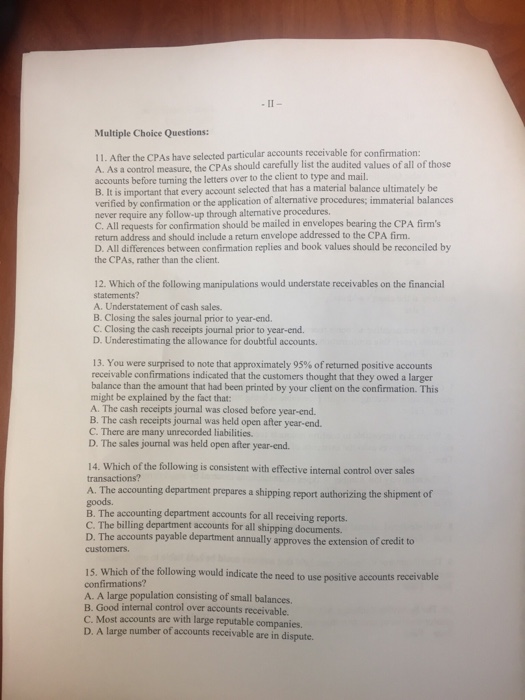After the CPAs have selected particular accounts receivable for confirmation : A. As a control measure, the CPAs should carefully list the audited values of all of those accounts before turning letters over to the client to type and mail. B. It is important that every account selected that has a material balance ultimately be verified confirmation or the application of alternative procedures; immaterial balances never require any follow-up through alternative procedures. c. All requests for confirmation should be mailed in envelopes bearing the CPA firm's return address and should include a return envelope addressed to the CPA firm. D. All differences between confirmation replies and book values should be reconciled by the CPAs, rather than the client. Which of the following manipulations would understate receivables on the financial statements? A. Understatement of cash sales. B. Closing the sales journal prior to year-end. C. Closing the cash receipts journal prior to year-end. D. Underestimating the allowance for doubtful accounts. You were surprised to note that approximately 95% of returned positive accounts receivable confirmations indicated that the customers thought that they owed a larger balance than the amount that had been printed by your client on the confirmation. This might be explained by the fact that: A. The cash receipts journal was closed before year-end. B. The cash receipts journal was held open after year-end. C. There are many unrecorded liabilities. D. The sales journal was held open after year-end. Which of the following is consistent with effective internal control over sales transactions? A. The accounting department prepares a shipping report authorizing the shipment of goods. B. The accounting department accounts for all receiving reports. C. The billing department accounts for all shipping documents. D. The accounts payable department annually approves the extension of credit to customers. Which of the following would indicate the need to use positive accounts receivable confirmations? A. A large population consisting of small balances. B. Good internal control over accounts receivable. c. Most accounts are with large reputable companies D. A large number of accounts receivable are in dispute







